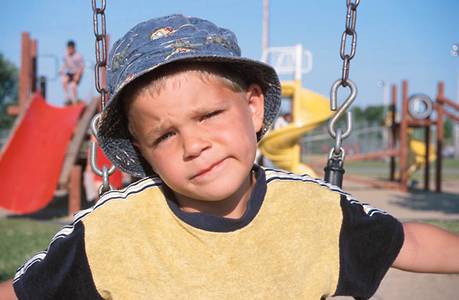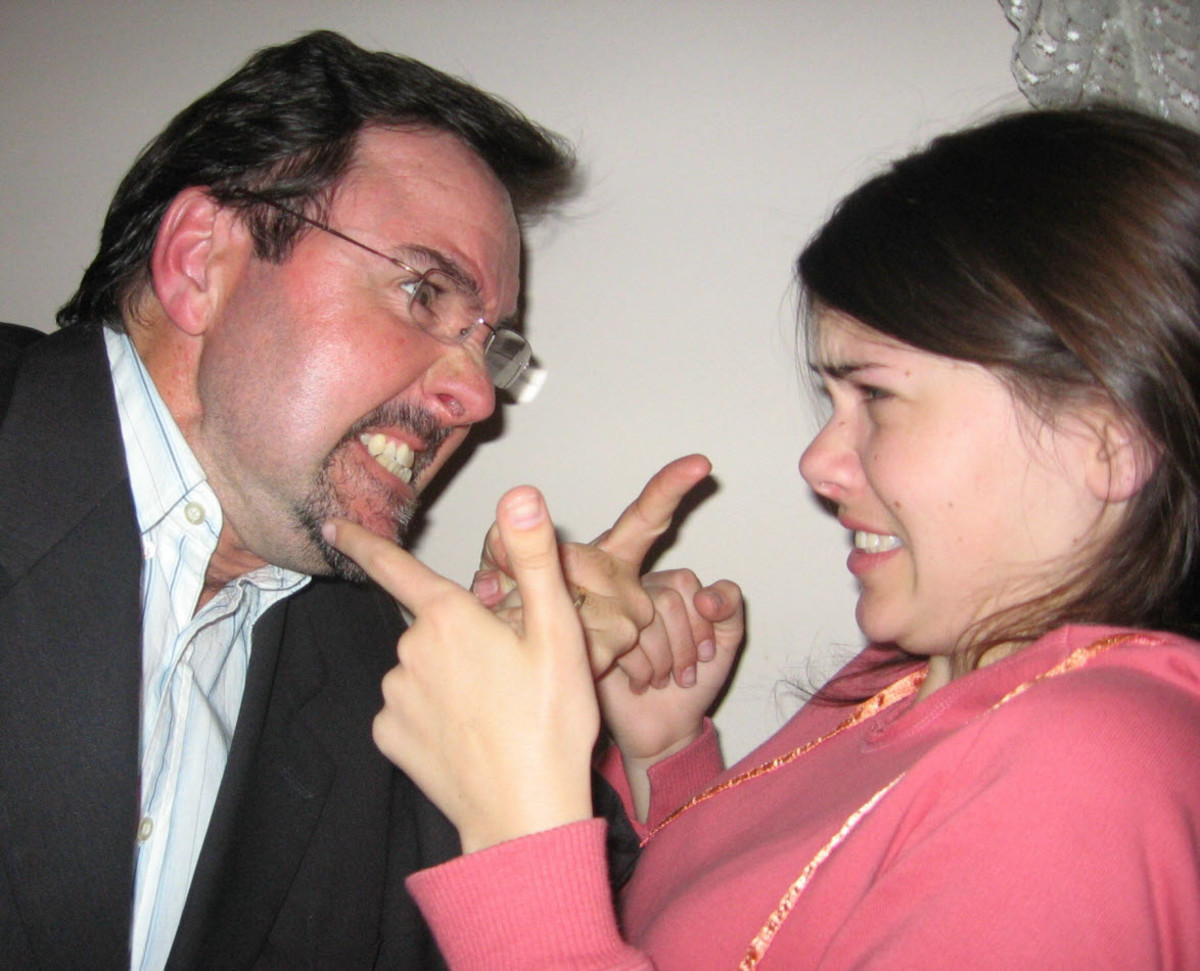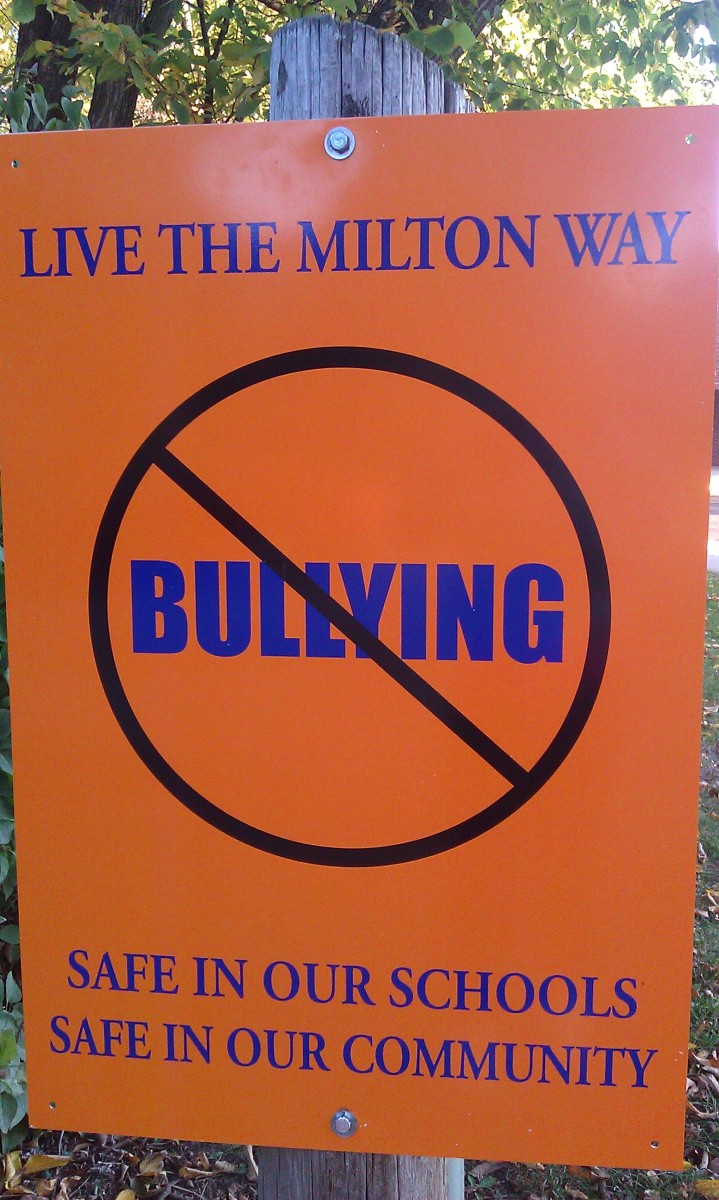Prevent Bullying

When I was a child a bully lived at the bottom of our hill. Bruce was only 12, but to my seven-year old eyes, he was as big and terrifying as a grown man.
The neighborhood mail box was directly in front of Bruce’s house and his particular pleasure was to torment the kids who came to post letters for their mothers. He would burst from the house screaming "GET AWAY FROM MY MAILBOX" and issue dire warnings of bodily harm if we dared post a letter there again. I was so sacred of Bruce I would pause to look for him before I passed his house. Then I would run to the mailbox, toss in the letters, and run again. Sometimes I would hear the little creep laughing, enjoying the effect he had on me.
The last time Bruce bullied me was a sneak attack. I had just put the letters in the mailbox and turned to find him, hands on hips, blocking the sidewalk and deliberately menacing me.
“I warned you about using my mailbox” he hissed.
Terrified, I turned and ran all the way around the block rather than dare pass Bruce. When I stumbled sobbing into our yard I ran straight into my older brother, Doug, who was talking with a friend. Annoyed at my intrusion he asked what my problem was and I choked out the story. Sensing a chance to show off, Doug took me and his friend back down the hill to the mailbox then sent me in to “mail” a letter. Bruce took the bait like the fool he was and charged out screaming threats, but stopped and blanched in fear when Doug and his friend stepped up.
Doug was 17 and towered over Bruce. He grabbed his shirt front with both hands, lifted him off the ground, held him close to his face and bellowed “ARE YOU BOTHERING MY SISTER?” “No”, Bruce managed to squeak. It was a ridiculous exchange of words, but delicious to me. Dangling from Doug’s hands I could see that Bruce was nothing more than a child. “IF YOU BOTHER MY SISTER AGAIN I’LL COME DOWN AND KICK YOUR ASS AROUND THE BLOCK!!” Doug tossed Bruce onto his butt then turned and walked off laughing with his friend, paying no further attention to me or the bully.
Even a seven year-old could tell that Doug’s intervention on my behalf was for his own entertainment and that he had been a bully himself. I didn’t let that interfere with my sublime pleasure seeing Bruce rumpled in a heap sniveling like a baby.
Plus, he never bothered me again.

The prevalence of bullying
There have been bullies as long as there have been schoolyards, playgrounds, alleys, and street corners for them to prowl and weaker victims to menace. In the past, bullying was not always viewed as destructive behavior but rather as a childhood rite-of-passage that kids had to endure, or an opportunity for them to learn to “stand up for themselves” and deal with problems.
It is now recognized that bullying can leave lasting emotional scars on the victim, resulting in depression, physical illness, social withdrawal, drug or alcohol use, and poor academic performance. And bullying has become particularly relentless in our electronic age when children can torment each other 24/7 with text messages, email, social networking sites, and cell phone photos. There is no safe haven when a bully can enter a child’s bedroom via computer and enlist an entire network of cohorts to enjoy the “fun”.
Bullying has become so prevalent that an estimated 160,000 students stay home from school every day rather than face more incidents, and as many as 1 in 10 children may endure repeated aggression. Congress even introduced a bill that would require schools to protect students from bullying after two 11-year old boys committed suicide in 2009, allegedly because they were relentlessly bullied by schoolmates for being “gay”. Congress, however, cannot legislate bullying away. Bullying prevention in schools requires the universal efforts of staff, students, and parents to teach respect, enforce discipline, identify problems, and monitor behavior.
What is bullying?
Bullying is repeated aggressive behavior that is intended to hurt or control another person. It occurs when there is an imbalance of power between the bully and the victim, who has a difficult time defending him or her self. The bully’s power can be derived from physical size, popularity, intellectual superiority, social standing, attractiveness, or other attribute the bully has and the target is perceived to lack.
There are four main forms of bullying:
Physical bullying involves using physical force to harm the victim such as hitting, shoving, grabbing, intimidating, or holding them down. The bully may also steal or break the target’s possessions or extort money from them.
Verbal bullying involves using words to hurt others. This includes teasing, taunting, name-calling, insulting, and ridiculing but can also involve hostile gestures like “making faces”, spitting, sniffing the victim, or staring.
Relational bullying is an effort to damage the target’s relationships with his or her peers. This can involve spreading malicious rumors, ostracizing, gossiping, or ignoring the target.
Cyberbullying is a relatively new development that refers to the use of cell phones, computers, texting, social networking websites, blogs or other means to send insulting or threatening messages to the victims or spread destructive rumors or gossip about them.
Boys more often engage in direct, physical bullying while girls tend to specialize in indirect, relational bullying.
Remember: bullying is hurtful, intentional, and repeated, and there is a power imbalance between the bully and the target.
Do not confuse bullying with conflict. People can have conflict and still remain respectful of each other because conflict does not necessarily involve a power inbalance or intentional harm. Kids can often resolve conflict on their own if given a little prompting. Bullying, however, requires adult intervention because the victim is unable to defend himself.

Signs of bullying
Kids will often not report bullying incidents because they are ashamed, figure it is their fault, think their parents won’t believe them or will urge them to fight back, or don’t want to be seen as snitches. If you child does not tell you about bullying there are warning signs to watch for:
- Social withdrawal or few friends
- Coming home with visible bruises or injuries
- Change in personality or behavior
- Sadness, anxiety, loss of appetite, not sleeping well
- Mood swings, cries easily
- Avoids certain situations or going certain places he used to enjoy
- Doesn’t want to go to school or take the bus
- Comes home with torn or soiled clothing
- Brings home damaged possessions
- Reports losing lunch money
- Talks about running away
- Unexplained anger
- Attempts to take a weapon to school
If you suspect your child is being bullied, start a casual conversation with him or her. Ask open ended questions such as “How was school today?”, “What games did you play at recess”?, “Who did you have lunch with today”?, “What did you have for lunch?”, “Who did you sit with on the bus?”, “What did you talk about?”, “How is your friend James?”, “Did you meet any new kids today?”.
If your normally talkative child is evasive or reluctant to answer such simple questions, they may be hiding a bullying situation. If she does not open up but continues to exhibit warning behavior you will have to be direct. Start out by emphasizing that you love her and that if she has a problem at school you will work out a solution together. Then ask if someone is deliberately trying to hurt her or make her unhappy.

Your child reports bullying
If your child does report bullying do not get angry, press too hard for information, or threaten harm to the bully. Control your emotions. You will probably be angry at the bully but any expressed anger may be interpreted by your child as anger at him. Remain calm but concerned.
Ask for specifics such as who is bullying him, how he is being bullied, where the incidents occur, and how often. Listen carefully and don’t make comments that imply your child provoked the bully or that the bullying is somehow his fault. Don’t criticize if you disagree with how he handled the situation and don’t immediately offer solutions. Ask your child what he thinks can be done to help and tell him that you will think about what to do.
Typical bad advice NOT to give children on handling bullies includes:
- Ignore it. Would you ignore it if someone bigger than you stopped you on the way to work, blocked your path, threatened you with bodily harm, stole your briefcase, and made you hand over your money? No! You would probably call the police and report an assault. Don’t expect your child to ignore repeated bullying.
- Sort it out between yourselves. Remember, bullying occurs when there is an imbalance of power. Your child is not in a position to negotiate or work it out. Also, he probably lacks the skills and confidence to deal with it on his own. That may be why he is in the bullying situation in the first place.
- Hit back. Although this advice may satisfy our thirst for instant justice it most times is impractical because the bully is usually bigger and stronger or there are multiple bullies. Your child could get seriously hurt or expelled from school for fighting. Why lower him to the level of the bully?
Stopping Bullying
The best way to stop bullying is to not let your child become a victim in the first place. Researchers have found that bullies tend to be very self-confident and like to bully others they perceive as shy, socially backward, meek, physically uncoordinated, less attractive, or less intelligent.
Make your child more bully-resistant :
- Instill self-confidence. Encourage your child to engage in activities, sports, and hobbies where he or she can excel. Praise their small triumphs and coach instead of criticize when they need direction. Help develop their talents and special attributes.
- Help your child establish good social skills. Teach them to be respectful of others, share their toys, and be a good friend. Observe his or her interactions with peers. If your child displays annoying behaviors like talking too much, boasting, whining, or being argumentative, he can be inadvertently inviting bullying because he is irritating. Your child may need counseling to learn appropriate group social skills.
- Encourage your child to make friends. Bullies prefer to attack victims who are alone. Multiple friendships also boost a child’s confidence and help her feel good about herself. The friendship pool should be diverse. Look for suitable friends among schoolmates, neighborhood children, sports teammates, or fellow members of clubs or auxiliary groups like the Scouts. Having a diverse group of friends teaches your child that he can be successful in various social settings.
- Teach your child to be assertive. This includes speaking up for herself if someone tries to intimidate her or put her down with unkind remarks. Practice with her to develop a firm, self-assured speaking voice. Try role playing and rehearse some replies that can defuse a bully’s taunts. For example, a girl might bully your daughter by criticizing her clothes or hairstyle. Tell your daughter to look the bully in the eye and ask “Why is that any concern of yours?” This is not the reaction the bully is expecting and she may back off and look for easier targets.
- Teach your child early that they must not let anyone touch them in a way that makes them uncomfortable. This includes sexual touching or bullying shoving or hitting. Tell them to walk away from the situation immediately and report the incident to a trusted adult. They must also tell you as soon as possible.
- Teach your child basic self defense; martial arts classes are good for confidence building and also introduce your child to new friends. But emphasize that self defense skills are used to protect oneself if attacked by a bully, not to encourage your child to fight the bully. Again, bullying always involves an imbalance of power so the bully is probably confident he can win a fight with your child. You child must have enough skill to defend himself until he can extricate himself and escape the situation with as little harm as possible.
- Preventing Classroom Bullying
What teachers can do - Cyberbullying FAQ For Teens National Crime Prevention Council
Frequently asked questions about cyberbullying. - What is Cyberbullying? National Crime Prevention Council
An explanation of cyberbullying and what parents and kids can do about it. - National Mental Health Information Center
Take Action Against Bullying - Stop Bullying Now!
Bullying Information, Resources, and Prevention Tips from the US Department of Health and Human Services.
Action parents should take
If you know or suspect your child is being bullied at school you should notify the school principal in person or through a telephone conversation and follow-up with a written synopsis of your discussion. Describe what you discussed, what action the principal agreed to take to resolve the situation, and what further action or contacts might be necessary. The written follow-up is vital because schools are obligated to respond to reports of bullying and it will strengthen your case if you must contact outside authorities.
Be calm and professional during your meeting with school officials. Provide the facts as you know them without becoming defensive, angry, or emotional. Listen carefully to what they have to say and give them an opportunity to investigate the situation and get back to you. Emphasize that you want to work with them to find an appropriate solution to the problem but make it clear that you expect the bullying to stop.
Do not contact the parents of the bully. That is the responsibility of the school officials. Besides, many times child bullies learn their aggressive behavior from their parents. You may find yourself attempting to deal with an adult bully.
If the bullying persists, contact school officials again and have a face-to face meeting. Emphasize again that an appropriate solution must be found immediately and ask what they intend to do. Follow up this meeting with a letter describing your expectations. If you sense the school is trying to whitewash or shrug off your concerns, you may have to suggest outside interventions might be necessary. These can include speaking with the school board or district superintendent, law enforcement agents, or an attorney.
Bullying that takes place off school grounds may be more difficult to handle. If you know the bullies are students from your child’s school, then approaching school officials is appropriate. But if you can’t identify the bullies, or they are non-students or other young adults, you may have to contact the police. Fortunately, it is much easier for your child to avoid non-school bullying situations by changing their routines or finding new places to hang out with friends.
Anti-Bully Programs
- Botvin LifeSkills Training
Bullying Prevention Programs - Edu Safe - Strategies for Prevention and Intervention
Learn how to enhance school safety through practical and common sense strategies - Olweus Bullying Prevention Program
The Olweus Program (pronounced Ol-VEY-us; the E sounds like a long A) is a comprehensive, school-wide program designed and evaluated for use in elementary, middle, or junior high schools. The programs goals are to reduce and prevent bullying proble
Action schools can take
All schools should have a written anti-bullying policy in place that emphasizes zero tolerance for any forms of bullying or violence on or off campus. Administrators can also survey students and the physical campus to pinpoint trouble spots where bullying most frequently takes place. Restrooms, locker rooms, stairwells, isolated hallways and any place known to be shielded from adult supervision are the most common sites for bullying. When problem areas are identified, school officials can devise means to better supervise them or make them off limits to students.
But bullying also takes place in the classroom under the gaze of teachers and staff, which makes universal cultural changes necessary. Many anti-bullying programs have been developed and are offered to schools to teach students and staff how to manage conflict and anger, respect individual differences and diversity, and practice positive behavior rather than aggression. Experts also agree that any anti-bully program must also deliver negative consequences to bullies.
Epilog
My personal bully Bruce moved away with his family about a year after my last encounter with him. I saw Bruce nine years later after a performance of our high school orchestra. His cousin Gary played the clarinet and Bruce came backstage to contragulate him for his excellent solo performance. I recognized Bruce immediately, even though he was now a young man in his early 20's. I watched how he joked and talked with Gary and could tell they were close; I was touched that he would come see his younger cousin play in a high school concert. That chance sighting gave me hope that Bruce outgrew his bully tendencies and had become a thoughtful, kind adult. I also wondered how much my brother's "intervention" had set Bruce on a different path.
We owe all kids a chance to grow up bully-free.








